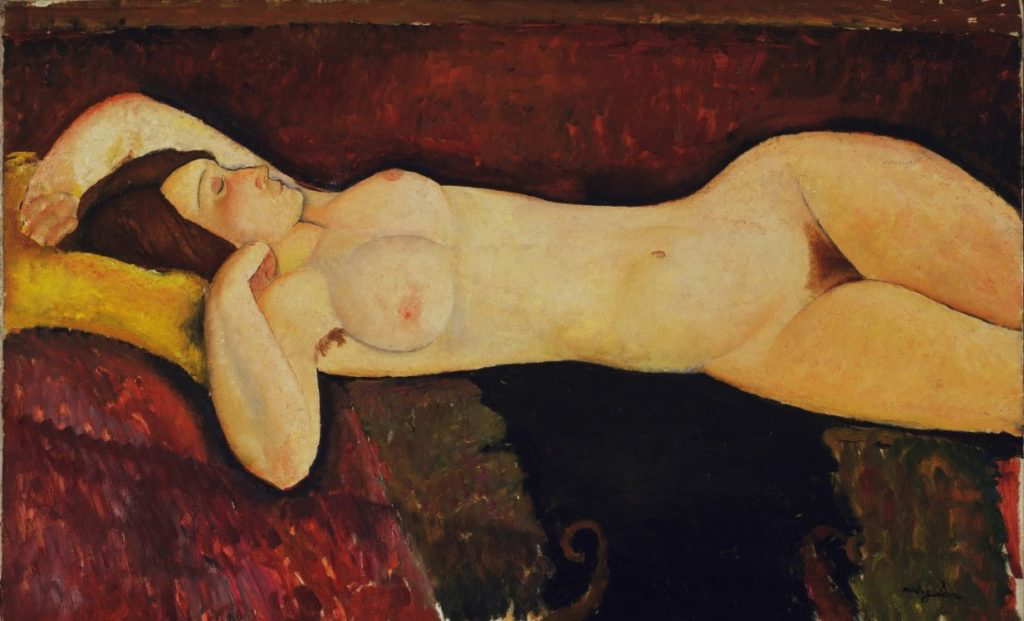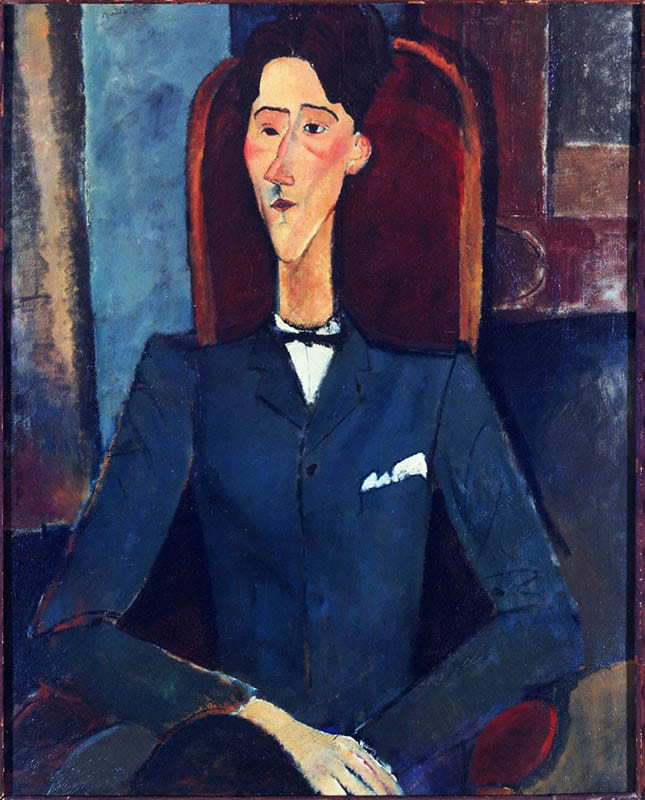
Amedeo Modigliani lived in a time in history when art movements were changing the creative landscape and war was shaping Europe and its social structures. He was inspired by life in the art districts of Paris, its avant-garde artists such as Picasso, Henri Toulouse-Lautrec and Henri Matisse and poets like Zborovski and Jean Cocteau. Once immersed in bohemian life in Paris, he developed an outrageous vagabond demeanor and growing addictions to alcohol and drugs. The resulting damage to his already precarious health was the deadly cost he eventually paid. However, he bequeathed to the world an extensive oeuvre including works that have been labeled scandalous, iconic, and magnificent.
1. Modigliani Lived A Short and Troubled Life

Amedeo Clemente Modigliani was born July 12, 1884 in Livorno, Italy. He was born to a wealthy, bourgeois, and well-educated family of Sephardic Jews (descended from Spain and Portugal). His family encouraged his ambition and exposed him to travel, literature and art.
However, Modigliani’s childhood was fraught with ill health. At age 11 he developed pleurisy and one year later he contracted typhoid fever. At 16 he developed pleurisy again, then contracted tuberculosis which would ultimately lead to his death. While he was sick and delirious with typhoid fever, he pleaded with his mother to take him to Florence to see the paintings in the Uffizi and Palazzo Pitti. His mother did eventually take him to see them and most notably, she enrolled him in classes with the painting master, Guglielmo Micheli. There he studied nineteenth-century Italian art, still-life, portraiture and the nude for two years from 1898 to 1900. His tutelage ended with the onset of tuberculosis.
2. Exposed To Influential Artists in Paris

In 1906, at the age of 21 and driven to develop his career as an artist, Modigliani left Italy and went to Paris. It was there in the Montmartre district where he met many avant-garde artists and his future patron Paul Alexandre at Le Bateau Lavoir. He met significant artists such as Pablo Picasso, Henri de Toulouse-Lautrec, and worked with painter Moise Kisling. His response to being immersed in the tumultuous artistic melting pot of Paris was a large outpouring of paintings, drawings, and sculptures. Even though Modigliani considered himself a sculptor in his early artistic career, over the last century he has become more widely known as a painter of portraits and nudes.
In 1908 Modigliani exhibited at the Salon des Indépendants, an independent, collective, annual art exhibition in Paris.
Italian, Jewish, playboy, painter, and sculptor, Modigliani lived a hard existence in abject poverty. He sold his drawings and paintings for a pittance to buy food and alcohol. His accommodations were harsh, and he was often ill from his indulgences in alcohol and drugs which compounded the weaknesses leftover from his childhood illnesses.
3. Modigliani Embarks on a Five Year Sculpture Challenge

Three years after Modigliani moved to Paris, his patron and friend Dr. Paul Alexandre introduced him to sculptor Constantin Brancusi. By all accounts, Brancusi inspired Modigliani to dedicate himself to sculpture and associated drawings for the next five years. This is also where he was introduced to African tribal carvings and masks and their styles of simplification of form. These early multicultural influences included African, Egyptian, Greek, and Khmer.
Get the latest articles delivered to your inbox
Sign up to our Free Weekly NewsletterBetween 1909 and 1914, Modigliani produced a significant collection of stone carvings of which twenty-five have survived. Standing nude is the largest of Modigliani’s stone sculptures standing 64.09 inches (162.8 cm) high. It is the only full-length, free-standing sculpture known to have survived. It is interesting to note that all his sculptures were of the human head except for Standing nude c. 1912, Australian National Gallery, and Caryatid c. 1914, Museum of Modern Art (MoMA), New York.

4. Fauvism: Art Movement Of The ‘Wild Beasts’

During his time in Paris, Modigliani also became loosely involved in the Fauvism art movement. Fauvist works can be characterized by energetic brushwork and intense colors as a means of conveying the emotional state of the artist. The Fauves, which translates as “wild beasts” were a collection of French painters, the most notable among them being Henri Matisse and Albert Marquet.
Modigliani created a large body of diverse work while living in the Parisian Montparnasse district. During the early part of the 20th century, this district was the artistic and intellectual hub of Paris. Modigliani developed a distinctive and recognizable style during his short and frantic artistic career. His paintings are well known for his elegant portrayal of women with recurring features including elongated arched necks and hands, and blank almond-shaped eyes.
During this time in Paris, Modigliani became known as Modi. The abbreviation translates from French as ‘cursed’. His contemporaries took that further calling him peintre maudit, meaning ‘cursed painter’.
5. Modigliani’s Fascination With The Human Form

Modigliani drew and painted the human form with very few exceptions. From 1916 to 1919, he created at least 26 paintings of female nudes. These were commissioned by the Polish writer, poet, and art dealer, Léopold Zborowski, who supplied his art materials, models, a stipend and an apartment for him to work in.
As these paintings were created in a series within a three-year period with a view to sell commercially, they differ from his earlier paintings of lovers and friends. Even though Modigliani borrowed from other more influential artists, these painted nudes are now considered by some to be radical and revolutionary in art culture for those times.
Some believe they may have changed the direction of the portrayal of women in art. However, the gains women made in their social power were due to the pressures of a world war. This was a more likely stimulus for women’s evolving and overt self-confidence displayed in portraiture and nudes. Modigliani depicted women in seductively confident poses as opposed to the timidity expressed in many artists’ works before that time.
His outpouring of portraits and nudes of women would have contributed greatly to his reputation as a wild playboy, one he made no effort to change.
6. Censoring Nudes

In 1917 Modigliani premiered in a ‘notorious’ one-man show at the Berthe Weill gallery. A large group of people gathered outside to view the nude hanging in the window. This attracted the police who then proceeded to shut down the one and only solo show in his lifetime on grounds of obscenity.
The nudes were considered scandalous and indecent because depicting pubic hair as explicitly as he did was not acceptable in the Parisian art world of that time. These nudes, however, modernized the painted female form at a time when the demands of war saw women claim more independence and strength. Modeling for artists was lucrative work, so for artists like Modigliani there was no shortage of attractive women to paint.
The majority of the nudes from the collection created 1916-1919 are now held in the Solomon R. Guggenheim Museum, The Museum of Modern Art, New York, The Metropolitan Museum of Art, New York, the Long Museum in Shanghai, and The Courtauld Gallery in London.
7. Lover of Poets and Writers

Modigliani was well-known for regularly reciting Dante and other famous poets. The writers and poets he painted included Jean Cocteau, Beatrice Hastings, Blaise Cendrars, and Guillaume Apollinaire. From 1914-1916, Modigliani and Beatrice Hastings shared an apartment in Montparnasse. They engaged in a tumultuous romantic affair and during their two years together, he painted her portrait 14 times. Together they lived an extraordinarily creative life while the war thundered around them, sometimes eating out of soup kitchens like many other starving creatives, artists, and writers.

8. A Monumental Tragedy

While Modigliani lived and worked in Le Bateau-Lavoir, he met the student Jeanne Hébuterne who became his lover, common-law wife and muse. She became a principal subject in his art.
Although Modigliani and Hébuterne’s social circle strengthened to include Pierre-Auguste Renoir, Pablo Picasso, and André Derain they left Paris to escape the war. While living in Nice where Hébuterne gave birth to their daughter Jeanne Modigliani (1918-1984). After returning to Paris in 1919, they fell pregnant with their second child and they became engaged to marry. When 21-year-old Hébuterne was eight months pregnant, Modigliani fell acutely ill with tubercular meningitis and died on January 24, 1920.
The next day Hébuterne was taken to her family home but was so grief-stricken she threw herself out of a fifth-floor window to her death. Their unborn baby died with her. Their daughter Jeanne was only 14 months old.
Many people from the artistic communities of Montparnasse and Montmartre attended the funeral. Modigliani and Hébuterne were buried separately until in 1930 her family allowed her body to be moved to share a grave and single tombstone. His epitaph says, “Struck down by Death at the moment of glory.” Hers reads, “Devoted companion to the extreme sacrifice”, Modigliani Foundation.
9. The Mask of Death

Death Mask of Amedeo Modigliani (1884-1920), c. 1920, Moïse Kisling, bronze, The Met
Soon after his death, Modigliani’s contemporaries Moïse Kisling, Conrad Moricand, and Jacques Lipchitz took twelve plaster molds and made Modigliani’s bronze death mask. The mask presents a haunting last depiction of an artist who embraced early 20th century Parisian hedonism and bohemianism so completely that it led to the end of an infamous career and his early death. But we are left with a body of work that went some way toward transforming the worlds of art and fashion, and a life story as tragic as it is fascinating.
Nu Couché $170.4 Million Sale at Auction
Modigliani was little known outside Paris while he lived. In the century since his death, his portraits and nudes have taken their place among the most significant paintings of the 20th century.

In 2015 Modigliani’s painting Nu Couché – sur le côté gauche (Reclining Nude) sold for a nine-figure sum at Christie’s in New York and is among the most expensive ever sold at auction. With headlines about sales of his paintings making world news, Modigliani has certainly become one of the great masters of the art world. Nu Couché is the largest painting he ever produced and was one of the censored nudes in his aborted Paris exhibition in 1917.
Modigliani was mostly unsuccessful at selling his art during his life and he died almost penniless. His paintings, drawings, and sculptures are now in respected museum collections around the world and adorning the walls of the super-wealthy. As his artworks change hands, the auction hammer slams down on ever-increasing prices and soaring values of the ‘genius’ output of Amedeo Modigliani.








